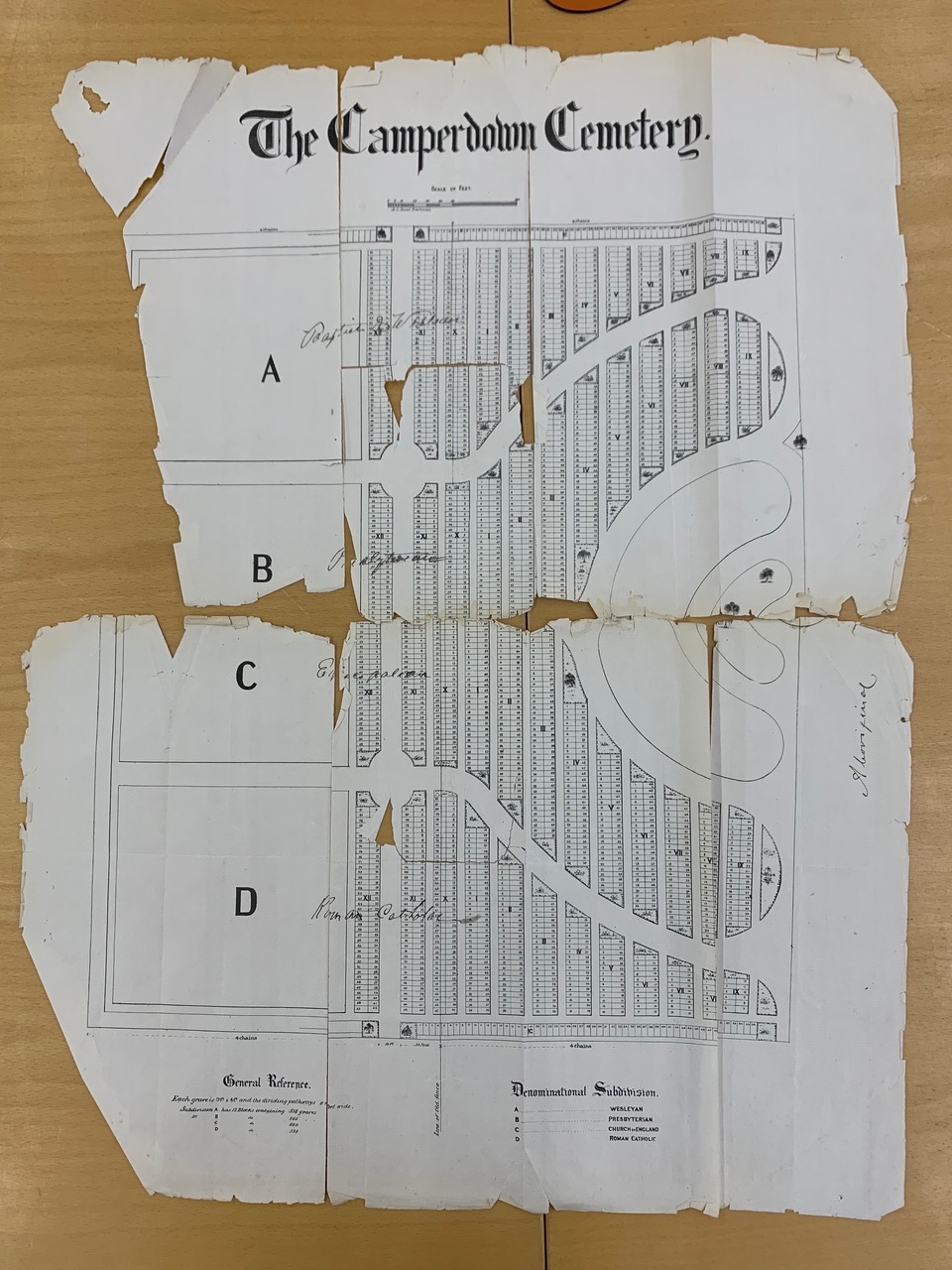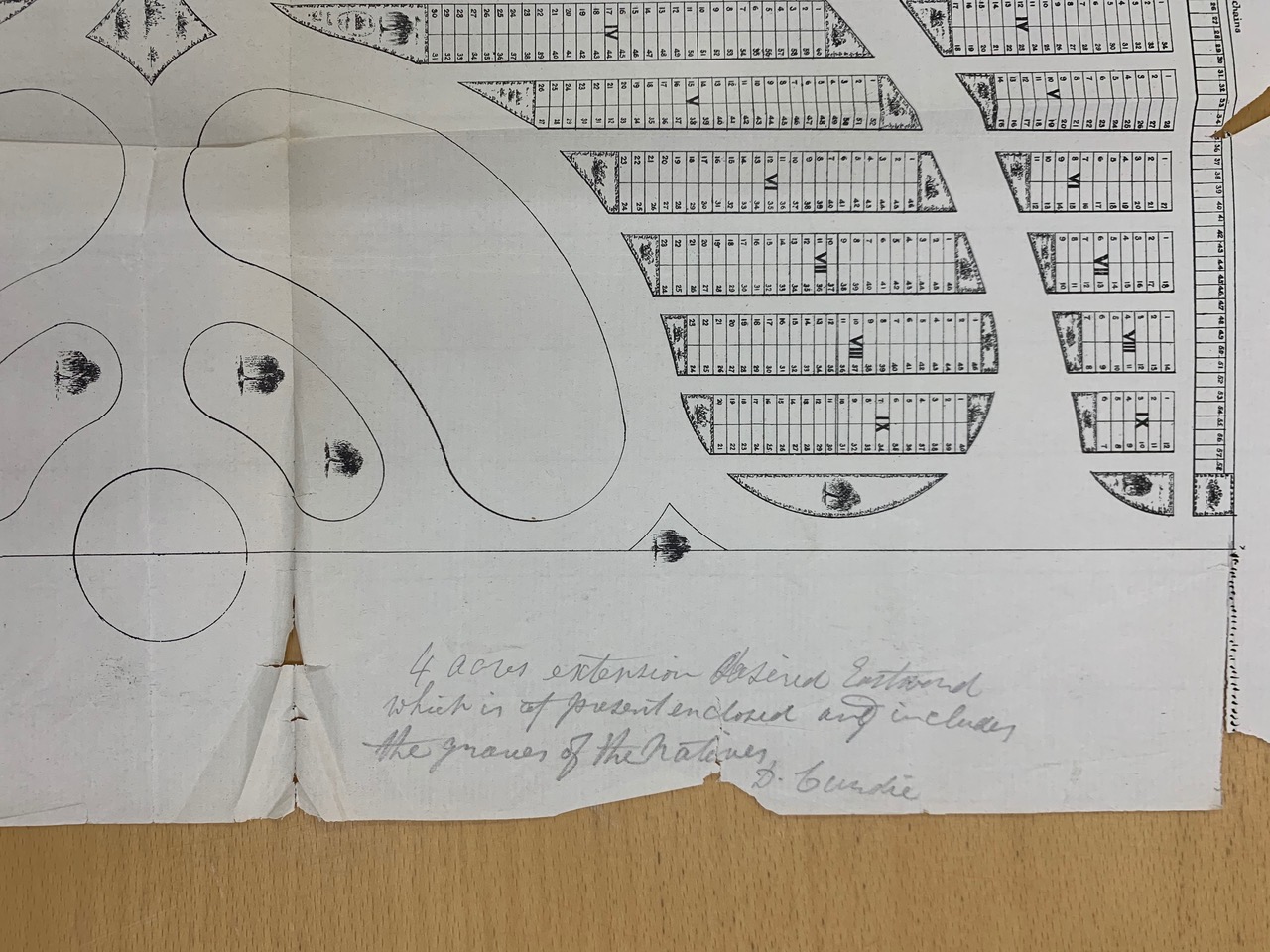Aboriginal Burials, Camperdown Cemetery
When the Camperdown Cemetery was established in 1854, Aboriginal people were buried in a marshy section of the cemetery which was considered unsuitable for burials of the white residents of the district. None of the Aboriginal burials were documented. Members of the Camperdown & District Historical Society have now been able to document nineteen burials of Aboriginals in the cemetery and have identified the general area where the burials took place.
DOCUMENTED ABORIGINAL BURIALS IN THE CAMPERDOWN CEMETERY
1. 1860 Buckley. Date of death3 July 1860.
2. 1861 Unidentified Aboriginal Female.
3. 1863 Prince Albert. Date of death 15 November 1863,
4. 1863 Barney. Date of death 28 July 1863,
- Biographical information\04. Barney\Barney Death Certificate.jpg,
- Biographical information\04. Barney\Barney article.pdf.
5. 1864 Polly. Date of death 30th November 1864,
- Biographical information\05. Polly\Polly Inquest.pdf,
- Biographical information\05. Polly\Polly Death Certificate.pdf
6. 1865 Mary. Date of death 22 February 1865,
- Biographical information\06. Mary\Mary Inquest.pdf,
- Biographical information\06. Mary\Mary Death Certificate.pdf
7. 1865 Eliza Ellen. Date of death 23 February 1865,
- Biographical information\07. Eliza Ellen\Eliza Ellen Inquest.pdf,
- Biographical information\07. Eliza Ellen\Eliza Ellen Death Certificate.pdf.
8. 1867 Harry. Date of death 13 February 1867,
9. 1867 Unidentified Aboriginal Female,
10. 1867 Blucher. Date of death 17 June 1867.
11. 1870 Dick Manifold. Date of death 23 September 1870,
- Biographical information\11. Dick Manifold\Dicky Death Certificate.pdf,
- Biographical information\11. Dick Manifold\Dick Manifold article.pdf,
- Biographical information\11. Dick Manifold\Dick Manifold and King Billy.pdf
12. 1871 Aboriginal Male skeleton,
13. 1876 Unidentified Aboriginal Male.
14. 1878 Gellibrand (of the Colac Tribe). Date of death 30 June 1878,
- Biographical information\14. Gellibrand\Gellibrand Death Certificate.pdf,
- Biographical information\14. Gellibrand\Gellibrand article.pdf,
- Biographical information\14. Gellibrand\Fred Kruger photo c. 1878.jpg
15. 1878 Unidentified Human remains,
- Biographical information\15. Unidentified Remains\1878 unidentified remains.pdf,
- Biographical information\15. Unidentified Remains\1878 unidentified remains death certificate.pdf
16. 1881 King Tom. Date of death 29 September 1881,
- Biographical information\16. King Tom\King Tom Death Certificate.pdf,
- Biographical information\16. King Tom\King Tom article.pdf,
- Biographical information\16. King Tom\King Tom photo c. mid 1878.jpg
- Biographical information\16. King Tom\Robert Dowling painting 1856.jpg
17. 1881 Tom Brown. Date of death 17 November 1881,
18. 1882 Skipton Jackey. Date of death 24 May 1882,
- Biographical information\18. Skipton Jackey\Skipton Jackey Inquest 1.jpg,
- Biographical information\18. Skipton Jackey\Skipton Jackey Inquest 2.jpg,
- Biographical information\18. Skipton Jackey\Skipton Jackey Inquest 3.jpg,
- Biographical information\18. Skipton Jackey\Skipton Jackey Inquest 4.jpg,
- Biographical information\18. Skipton Jackey\Skipton Jackey Inquest 5.jpg,
- Biographical information\18. Skipton Jackey\Skipton Jackey Death Certificate.pdf,
- Biographical information\18. Skipton Jackey\Skipton Jackey article.pdf,
19. 1883 Wombeetch Puyuun. Date of death 26 February 1883,
- Biographical information\19. Wombeetch Puyuun\Death Certificate.pdf,
- Biographical information\19. Wombeetch Puyuun\CC article – death.pdf,
- Biographical information\19. Wombeetch Puyuun\James Dawson letter to CC 1877.pdf
CAMPERDOWN CEMETERY
Eight acres of land for a Camperdown Cemetery was gazetted in 1854. The eastern half (on the Camperdown side) of the cemetery was problematic from the start, due to the low lying, marshy nature of the ground which made it unsuitable for burials. On 28th July 1863 the Trustees wrote to the Lands Department requesting that four acres of land on the western side, adjacent to Lake Gnotuk, be swapped for the marshy ground on the eastern side. Approval was given on 3rd September 1863.
The first Aboriginal burial we have been able to document took place in 1860. The Aboriginals were buried in the low lying, marshy eastern area of the cemetery, which was unconsecrated ground and considered to be unsuitable for burials of white residents.
In 1871, Dr. Daniel Curdie, as the Chairman of Trustees wrote to the Lands Department again, requesting that the “marshy” four acres of land be reinstated, due to it being the burial place of the Aboriginals, which had been overlooked when the request was made in 1863.
Cemetery Correspondence – 1871 Original and 1871 transcript
In 1987, the Cemetery Trustees sought an extension to the area of the cemetery, as the cemetery was running out of suitable burial sites. Approval was given for land to be purchased on the north side (Princes Highway side) of the cemetery, with some of the expense to be offset by the sale of two and a half acres of unused land and the Sexton’s cottage, on the east side of the cemetery. At this time the Trustees were unaware that Aboriginal burials had taken place on this land, which is now privately owned.


